Caring for outdoor objects
Debra Daly Hartin, Wendy Baker, Robert Barclay and George Prytulak
Caring for outdoor objects is part of CCI’s Preventive conservation guidelines for collections online resource. This section presents key aspects of managing the care of objects in heritage collections in an outdoor setting based on the principles of preventive conservation and risk management.
Table of contents
- Understanding outdoor objects and planning ahead
- Causes of damage to outdoor objects and preventive conservation strategies
- Examples in preventive conservation practices
- Bibliography
Understanding outdoor objects and planning ahead
Outdoor collections
Typical objects accessioned in museum collections and displayed outdoors include bells from fire halls or churches, ships’ anchors, chains and bollards, machinery, large vehicles, including trains, military and farm equipment and monumental, sculptural works of art. Often, these objects are positioned in front of the museum to act as advertisements. The materials used in these objects are as varied as the objects themselves.
When considering the care of outdoor objects, it is useful to distinguish between two groups of outdoor collections. The first group is represented by objects that were always intended for outdoor display or use and whose manufacture and material components were designed to withstand the outdoor environment (Figure 1). Into this group fall, for instance, cast metal sculptures, outdoor murals and transportation vehicles (carriages, carts, cars, trains, etc.). These objects require periodic inspection to guard against damage from physical forces, thieves and vandals. Periodic and regular maintenance is necessary (e.g. to renew protective surface finishes to prevent degradation). Bases, plinths, mounting brackets and supporting armatures are also part of the object or work of art, and the entire assembly, having been designed for outdoor conditions, should be capable of withstanding the local outdoor environment with reasonable vigilance on the part of the owner and with regularly scheduled maintenance.

Figure 1. Sound the Alarm by Robert K. Spaith, bronze and wood sculpture, 1999, part of the “Ghost Collection ” of public art in the City of Red Deer, Alberta.
The second group of objects may have been intended for extended outdoor exposure, but these objects are sensitive to one or more of the inevitable agents of deterioration such as light, ultraviolet (UV), water, temperature and pollutants. Often these objects are meant to be replaced on a regular basis (such as outdoor signage). Into this group fall objects where aging and deterioration are a natural and expected part of the life cycle (e.g. totem poles). These objects, as part of a museum collection, must be closely monitored and continually maintained (surface cleaning, reapplication of coatings, winter protection, etc.).
A number of objects may be kept outdoors for lack of an indoor solution. The great majority of museums keep at least one or two objects outdoors through force of necessity; these items are often too large and cumbersome to be enclosed within the building, such as the wagon gear in Figure 2. In ideal circumstances, these objects would be kept under cover, as many of the agents of deterioration can be minimized or even eliminated by shelter or display in a secure indoor location.

Figure 2. Large wagon gear on outdoor display at the Timber Village Museum in Blind River, Ontario.
Though there are some common preventive conservation strategies for the groups of objects described above, individual items within each group often have unique needs and require a customized approach towards risk mitigation. The goal of this online resource is to provide strategies that can be used to address poor conditions or damaging situations until better solutions can be found.
Planning for preservation
Historic objects
Museums need to consider very seriously the choice of objects to display outdoors. All objects are eventually subject to deterioration, unless they are maintained. Even those items designed for outdoor exposure will eventually succumb to wear if not carefully maintained and protected. There are few coatings, for instance, that will resist weathering by exposure to wind and water, few surfaces that will not deteriorate from pollutants and pests or resist temperature extremes or exposure to high light levels. Historic objects, by their very nature, are more vulnerable to deterioration, given their age or possible history of neglect. Extra care will be required for their long-term preservation. Display situations should always default to indoor or fully sheltered locations. Where this is not possible, then only those items with the best opportunity for long-term survival should be placed in an outdoor environment. Placement and protective measures as well as inspection and maintenance procedures must take into account the vulnerabilities of the specific object.
New or commissioned acquisitions
Planning for outdoor exposure is very important from the initial discussion and design phase of a project to the fabrication of the object. The durability of these objects and their support structures is largely contingent on their materials, fabrication and design. Selecting an appropriate site and installation method, as well as planning and budgeting for ongoing maintenance, is also required to ensure that the object can withstand the rigours of the outdoor environment. Fabrication, installation and maintenance of the object will involve several partners: the artist/fabricator, possibly structural engineers, professionals with experience in large-scale installations, municipal authorities, etc.
Assessment of materials
Many objects displayed outdoors through force of necessity, such as industrial objects or vehicles, were constructed for a specific use with a certain life expectancy. While in use over this defined period, they were maintained to preserve their functionality and appearance. If, for instance, surface finishes deteriorated, they were replaced. Although functionality is not always a feature of the museum object, and does not necessarily require upkeep, finishes and coatings are vital to the protection of the object. Without these protective layers (varnish, paint, wax, chemical patinas), the underlying structures are subject to deterioration. These finishes or coatings are subject to weathering: fading, chalking, embrittlement, breakage and loss of material with ongoing exposure.
Additionally, the design must not create the potential for damage; for example, dissimilar metals should not be in contact with each other, water should not be able to pool in recesses or enter hollow cavities and drain holes should be added to hollow structures to allow any water that does collect to drain. Each work of art is unique and will have its own issues with regard to its maintenance and conservation (Figure 3).

Figure 3. Choices by Barbara Paterson. Part of the “Ghost Collection” of public art in the City of Red Deer, Alberta, installed in 1995. The work depicts a railway worker and a dog in a confrontational stance over a dollar bill on the ground. The patinated bronze surfaces can withstand the weather if regularly maintained with a protective wax coating. The statue’s design allows only a few areas where water and dirt can collect.
Choice of site
The site for outdoor display must be chosen with certain criteria in mind. Before installation, the potential site should be assessed as to whether it is appropriate in terms of its environment (e.g. light, water, pollutants, wind), use, physical accessibility and susceptibility to crime and vandalism. Points to consider include:
- Is the site dry and protected from strong winds and abrasives (e.g. sand and fine dirt particles)?
- Is the site used for activities that may be hazardous to the object, such as skateboarding, ball hockey or other street sports and activities?
- Does the location encourage physical interaction with the public (e.g. climbing, touching)?
- Is the location vulnerable to site maintenance activities, such as snowplowing, lawn maintenance or vehicle parking?
- Can maintenance activities be safely and conveniently carried out?
Once you have taken these considerations into account, much damage and deterioration will be prevented (Figure 4).

Figure 4. View of the downtown setting for Choices by Barbara Paterson.
The two statues in Figure 4 are mounted on a concrete and stone aggregate sidewalk that slopes down towards the street, shedding water well. Rainwater flowing on the rough sidewalk can effectively wash away dirt and debris. There is no grass in the vicinity (which often creates problems related to moisture and mowing). At the left of the statue, the building’s main entrance incorporates outside security video monitoring. The building’s slight second storey overhang provides some protection from the elements. Overall, access, visibility, drainage and security are very good. Based on a 2011 examination, this piece is in remarkably good condition and much of this can be credited to the sculpture’s durable materials, superior design and excellent location.
For further information on specific types of objects displayed outdoors, such as outdoor murals, totem poles, machinery and vehicles, consult the following CCI resources:
- Conservation guidelines for outdoor murals
- CCI Note 6/8 Totem Poles Displayed Outside
- CCI Note 15/2 Care of Machinery Artifacts Displayed or Stored Outside
Maintenance
For any outdoor object, maintenance and intervention are required to manage threats from exposure. A maintenance plan for each object, supported with a budget, is crucial to slow down deterioration and to prevent loss. Well-defined roles and responsibilities for inspection and maintenance should be assigned. It should also be clear who to contact for treatment advice and who has the authority to approve treatment proposals. It is vital that recommendations for maintenance be established with the artist, the collections manager and a technical expert such as a conservation professional. Schedules for inspection, cleaning and the application of coatings can then be determined and implemented.
A maintenance plan involves periodic inspections and maintenance activities, the notes of which should be documented and filed. Semi-annual inspections—generally in the fall and spring—will help detect instability or potentially hazardous conditions before major damage or deterioration occurs. For an example of a Condition report and inspection report, consult Conservation guidelines for outdoor murals.
It is helpful to connect routine maintenance of outdoor objects with building maintenance schedules. At heritage sites with many buildings to look after, the inclusion of outdoor objects in the maintenance schedule can help to give consistent attention to problems before they become critical. Often, structures that do not house people nor directly support their activities can be ignored and neglected.
Maintenance of outdoor heritage objects can be very time-consuming and expensive, and it is always wise to compare the costs of long-term outdoor care with the one‑time cost of providing secure indoor storage and display, where appropriate. The advice described in this resource is clearly limited to what can feasibly be accomplished; so in many cases, the advice to “bring historical objects indoors” cannot be overstressed.
In the case of artworks intended for outdoor exposure, routine maintenance is critical to prevent deterioration and the need for major, expensive treatment. Maintenance can include periodic cleaning as well as the application and reapplication of anti-graffiti or water-repellent coatings. Maintenance needs, its budget and the ease with which maintenance procedures can be undertaken should be considered in the planning phase of the commission or purchase. Preventive conservation, maintenance and treatment of objects displayed outdoors require collaboration and are a shared responsibility with many experts. The appropriate action when replacing varnishes and coatings, for example, will involve the input of the curator/owner, a conservator and the artist. Be aware that inappropriate or aggressive cleaning methods, which remove original patina or coatings and expose underlying surfaces to ongoing deterioration, can be worse than benign neglect.
Causes of damage to outdoor objects and preventive conservation strategies
With indoor display and storage, the main agents of deterioration are fewer, are less severe and can be more easily controlled. In outdoor conditions, by contrast, objects are exposed to most of the agents of deterioration year-round. A temperate climate with seasonal extremes in temperature and rapid freeze-thaw cycling puts most natural and synthetic materials under stress. More stress is added through exposure to periodic and prolonged high levels of light and UV, water, wind and wind-borne particulates and pollutants, as well as contact with many and varied flora and fauna. Outdoor objects are normally displayed in areas accessible to large numbers of people and frequently without sufficient surveillance or security. This makes them vulnerable to both inadvertent and deliberate physical damage and vandalism as well as to loss from theft. Sites or objects that are attractive to children or that encourage interactivity will require special considerations as they may be vulnerable to damage from play or sports activities and could present public safety hazards. Sites or objects in the outdoor public realm are also exposed to the hazards of maintenance of the site itself, e.g. snow clearing, lawn maintenance and sprinklers.
Preservation strategies that can prevent damage or help to mitigate the extent of damage are discussed below in association with particular agents of deterioration.
Physical forces
Objects displayed outdoors are often exposed to damage from physical contact with the general public (Figure 5) and physical hazards associated with the use and maintenance of the site. Such damage can include:
- dents, abrasion, punctures and breakage from contact with cars, snow removal and lawn maintenance equipment, falling trees and branches
- dents and abrasion from balls, hockey pucks, etc.
- abrasion and scratches from pedestrian traffic
- abrasion, loss or scouring of surface material and finishes from wind-driven particulates
- abrasion from overly aggressive cleaning methods
- vibration from seismic shocks, traffic or strong wind

Figure 5. Base of the statue of Sir John A. Macdonald on Parliament Hill, Ottawa, showing considerable wear on the female figure’s lap, clothing and feet.
Recommendations
- Assess the display site, prior to installation, for appropriateness of site features and maintenance requirements, for its accessibility (secured, protected) and for its use.
- Determine if an enclosure or semi-enclosed space can be designed for the object to provide a physical barrier.
- If an enclosure is not possible, when the object is installed, erect barriers and/or instructional signs around it to prevent visitor contact and to encourage respect for the cultural value of the object.
- Ensure that architectural and landscape features (roof extensions, branches) do not overhang, as there is a potential for damage from breakage or the falling of ice and snow.
- Surround the object with soft ground cover as an alternative to gravel or stones, which can cause denting and abrasion if thrown.
- Locate or mount the object so that it is not subject to the hazards of heavy equipment or maintenance activities.
- Avoid using mechanical snow clearing or mowing equipment close to objects.
- Educate grounds maintenance workers on the impact of their activities on the condition of the objects, and encourage them to report any changes or damages that they may note.
- Establish a practice of notifying collection managers of building or ground maintenance work in the vicinity of outdoor objects.
- Identify roles and responsibilities with regard to inspections, maintenance and possible treatment of damage.
- Institute a regular maintenance program with work performed by a trained individual.
- Undertake routine inspections.
Thieves and vandals
The high public visibility of outdoor objects makes them targets for damage by vandals (Figure 6). Vandalism is frequently opportunistic, and defacement or damage to an outdoor object can occur, especially if it is accessible and not under any form of surveillance. Some outdoor objects are prone to attack due to their nature, which can either be provocative in meaning or appearance, or at variance with community values. Extra sensitivity and forethought, along with specific precautions, are necessary when choosing to display such objects outdoors.

Figure 6. Part of an outdoor sculpture installation entitled The Baggage Handler by Michael Hermesh. This suitcase was slashed in an ongoing series of defacements done to the overall installation.
Theft of components of outdoor objects is a continual risk, especially where the components have some monetary value. Theft of metal outdoor art is not uncommon as the price for scrap metal has increased in recent years. Copper-based art is especially vulnerable. Detachable items, such as metallic nameplates, dials, gauges and controls, all have the potential of being stolen. An example of the protection of objects from this type of loss is described under Collectible or breakable components.
Recommendations
- Assess whether the site is appropriate in terms of its susceptibility to crime and vandalism.
- Consider displaying the object in an enclosed or semi-enclosed space.
- Avoid secluded locations and maintain clear lines of sight to objects. Trim tree branches that are below 1.5 m from the ground, which can impede the line of sight, and maintain hedges and bushes at no more than 0.4 m in height.
- Erect barriers and/or instructional signs around the object to prevent visitor access and to encourage respect for the artwork or heritage object.
- Illuminate the site at night.
- Monitor the site.
- Consider installing a security system to provide continuous monitoring of the site and objects.
- Employ full-time visitor supervision (guides) and security guards.
- Secure, if appropriate, all removable parts on the object.
- Remove, if appropriate, all collectible items from the object, such as nameplates, controls, gauges, levers, etc.
- If removed, keep all collectible items in a secure place indoors.
- Label removed parts. Prevent dissociation from the object by documenting their storage location within the museum’s documentation system.
- Inspect regularly for losses.
- Notify local authorities of the outdoor display, with the goal of encouraging them to deploy patrol vehicles in the neighbourhood to reinforce a protective zone.
- Consider initiatives to encourage the general public to report vandalism or damaging activities to museum or public officials.
- Repair damage or remove graffiti promptly as a deterrent to its recurrence. Graffiti removal should be undertaken by a qualified professional or individual with approval, according to established roles and responsibilities.
- To prevent graffiti, consider an anti-graffiti coating. A conservation professional in consultation with industry or product experts will be able to advise on a coating with suitable properties and on its application and removal, as well as maintenance procedures for the object.
- If graffiti becomes a problem, reconsider security measures, lighting and visibility. Removal and relocation of the object may be required.
- An attractive, well-maintained site can deter vandalism.
Dissociation
In the case of objects displayed outdoors, dissociation relates to missing information. At a minimum, it is important to know the name of the artist or fabricator, the date of fabrication as well as the owner. When this information is no longer associated with the object, there is an immediate loss of meaning. Loss of the object’s meaning to the community can promote neglect and leave the object susceptible to vandalism. If displayed without identification (e.g. a plaque) or explanation, or if changes to the display environment dissociate the object from its original context and meaning, the object may not be respected as having historical, social or artistic significance.
Dissociation can also occur as a result of loss of information about the object due to a change of ownership or misplacement of documentation relating to the object (e.g. provenance, fabrication history, fabricator specifications, history of restoration or maintenance). Items removed from the object for safekeeping can be lost, which can directly affect the intrinsic value and meaning of the object.
Recommendations
- Provide information about the object as part of the display, and ensure that this information remains legible.
- Ensure that all documentation pertinent to the object remains in an accessible location and is kept up to date.
- Ensure that all materials associated with the object, but not displayed with it, are secured and documented (in both written and photographic formats).
Water
Much of the damage to outdoor objects described as physical weathering is caused by water alone or in association with other elements of the outdoor environment (Figures 7a and 7b). Water is especially damaging when outdoor temperatures drop below freezing.
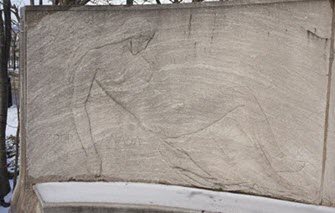
Figure 7a. Proper right side of the stone base of the Robert Baldwin and Louis-Hippolyte Lafontaine monument by Walter Allward, Parliament Hill, Ottawa.
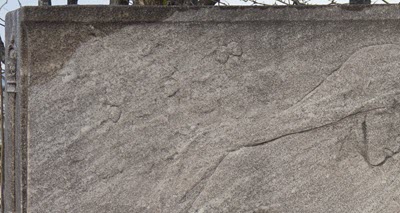
Figure 7b. Detail of the stone base in Figure 7a. This surface, displayed outdoors since 1913, has lost the fine detailing on the low-relief carving from exposure to wind and rain.
Freeze-thaw cycles
In climates where the temperature regularly falls below freezing, outdoor objects are vulnerable to damage that happens when water enters the structure and subsequently freezes and expands as the temperature drops. Freezing produces bursting pressure within materials (Figures 8, 9a and 9b). This bursting pressure—also known as frost wedging—causes severe damage to objects. As cracks develop, liquid water is able to penetrate more efficiently and to a larger extent into the affected materials and will provoke further damage in a subsequent period of freezing.

Figure 8. With repeated wetting and cyclical freeze-thaw, the crack in this dolomitic limestone has worsened. Small chips of stone are now spalling from the edges of the crack. The yellow discolouration is due to a well-meant but ineffectual attempt to waterproof the damage using silicone adhesive.
Water trapped or having entered a structure through gaps, depressions, fissures, holes and seams will freeze and expand, cracking and breaking apart the surrounding material. Even the sturdiest of objects are subject to this form of damage. If water can enter a hollow cast metal sculpture, for example, it will settle in the lowest point (usually feet, ankles, lower leg) or be absorbed by material remaining within the sculpture from the casting process and will cause damage as the temperatures fall below freezing.
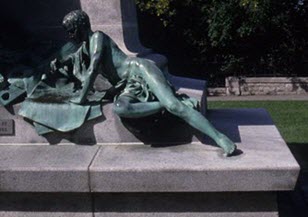
Figure 9a. Detail of Alexander Mackenzie statue by Louis-Philippe Hébert, cast bronze, Parliament Hill, Ottawa.

Figure 9b. Detail of statue shown in Figure 9a. Water was able to enter this sculpture, collecting in the lowest point—the foot. When the collected water froze in winter conditions, the pressure caused the metal of the foot to break apart. This situation can be aggravated by hygroscopic materials such as plaster left within the metal cast. The freezing and expansion of water trapped in these materials will cause cracks to develop and progressively worsen.
As many cast metal sculptures have intrinsic flaws (cracks or incompletely formed joints) from the casting process, drain holes are usually intentionally provided at the lowest point of the sculpture to allow for the escape of collected water (Figures 10a, 10b, 11a and 11b). These should never be blocked.

Figure 10a. Queen Elizabeth II equestrian statue by Jack Harman, bronze, unveiled in 1992 on Parliament Hill, Ottawa.
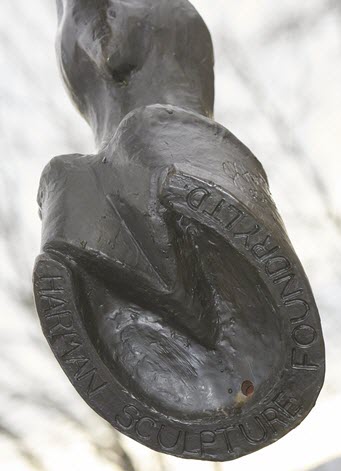
Figure 10b. Detail of the equestrian statue shown in figure 10a. A drain hole has been provided at a low point of the raised hoof to allow any water that might collect within the sculpture to escape.
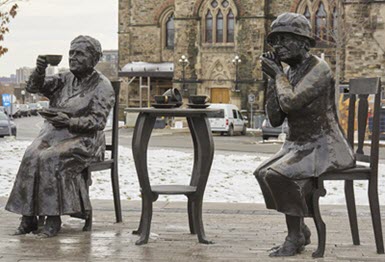
Figure 11a. Women are Persons! sculptures by Barbara Paterson, bronze, unveiled in 2000 on Parliament Hill, Ottawa.
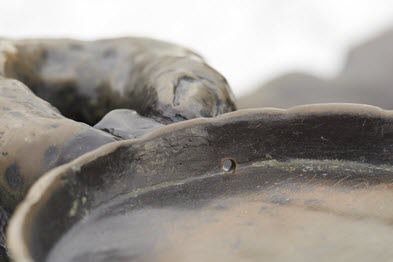
figure 11b. Detail of monument shown in Figure 11a. A drain hole has been provided in the side of the teacup to prevent water from collecting in the recessed area of the cup.
Movement of salts
Another form of physical weathering directly associated with water results from the crystallization of water-soluble salts within and on the surface of porous materials like brick and stone. Water entering porous materials can either carry dissolved salts from another source or can dissolve salts already present in the outdoor object. These salts move with the water through the material and are eventually deposited as salt crystals (efflorescence) on or near the surface of the object as the water gradually evaporates from the surface. The formation of the salt crystals exerts a very large pressure when the forming crystals are trapped below a surface layer. Material will be pushed apart in the region of crystallization, with a subsequent loss or weakening of surface layers.
Staining
Deposits of water-borne impurities can cause staining in porous materials. Rusty iron stains or green-coloured copper stains on stonework or concrete are the result of the oxidation of metallic impurities carried by rainwater across and into the porous substrate (Figure 12a). Metallic impurities can also be spread by repeated exposure of the object to mineral-rich (hard) well water (Figure 12b) or to groundwater run-off.
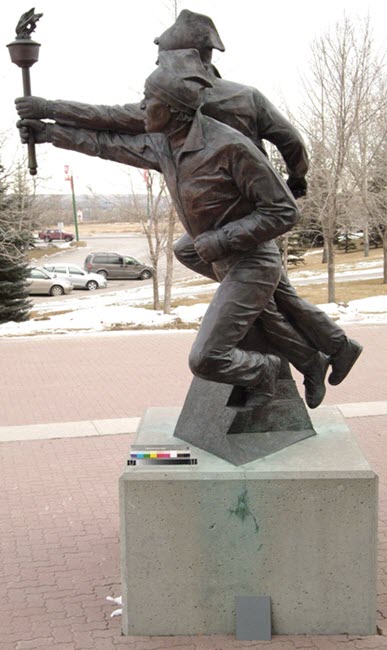
Figure 12a. Share the Flame, by Vilem Zach, 1989, located outside the Visitors Centre at the Canada Olympic Park in Calgary, Alberta. Copper originating from the bronze statue has been carried by rainwater and melting snow over and into the supporting concrete block. As the copper particles oxidize, a typical green corrosion stain becomes apparent.
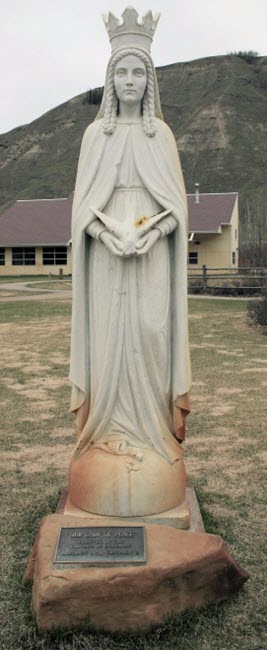
Figure 12b. Marble sculpture of Lady of Peace with rust stains from lawn watering with iron-rich water supply.
Corrosion
Corrosion of metals in the presence of water alone and in combination with salt (electrolyte solutions) is the cause of significant damage to outdoor metal objects or objects with metal components (Figure 13).

Figure 13. A ship’s iron anchor showing a cavity where rain water collects, causing corrosion of the metal and consequent staining of the concrete base.
Layers of corrosion products can form on most metal surfaces. The colour and thickness of these corrosion products can vary. Corrosion can provoke erosion and pitting of the metal surface that results in a changed and unsightly appearance. The rates of these reactions are increased by the presence of salts, e.g. from de‑icing salts or in marine environments.
Corrosion products generally occupy more physical space than the pure metal, so pins, bolts and other securing mechanisms within an object will expand when corroded, resulting in cracking and bursting of materials in the region of corrosion. This is a common occurrence when water penetration causes reinforcing metal rebar to corrode in concrete constructions.
If two different metals are in close contact and are linked by an electrically conductive path through water in the presence of dissolved salts, a galvanic cell is created, resulting in rapid corrosion of the less noble of the two metals (Figure 14).

Figure 14. White corrosion has developed on aluminum in contact with a copper alloy bolt. This is evidence of galvanic corrosion caused when a more active metal (aluminum) is in direct contact with a less active metal (copper alloy).
For more in-depth information on metals and corrosion, consult “Corrosion of Artifacts Displayed in Outdoor Environments” (Selwyn and Roberge 2006) and Metals and Corrosion: A Handbook for the Conservation Professional (Selwyn 2004).
Effects on wood
Exposed, untreated wood is quickly subject to degradation from water, especially if the wood cannot dry out. Where wood is buried or secured in constantly damp conditions, such as at the bases of totem poles, rot in these regions can proceed rapidly (Figures 15a and 15b).
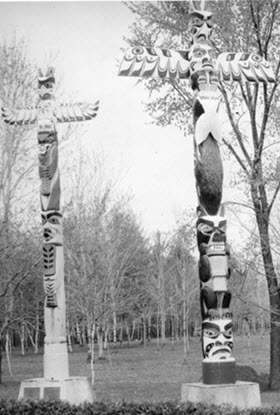
Figure 15a. Totem poles by Simon Charlie (Zoo de Granby, Quebec) were exhibited outdoors with the bases set into concrete pads and secured with metal sleeves. Displayed in this setting for 50 years, the lower extremities are showing the effects of exposure to water that collected at the bases.
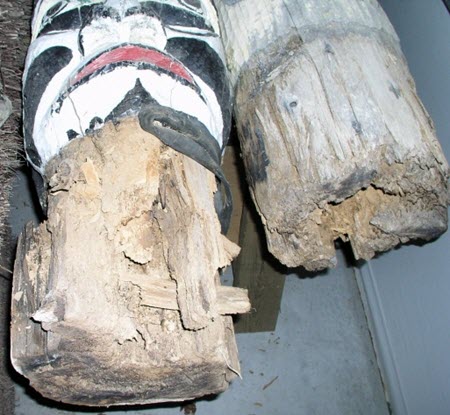
Figure 15b. Both poles, when removed from their outdoor location, show wood rot at their bases.
Water will attack coated wood, penetrating paints and coatings applied as decorative or preservative finishes through any tiny gap or fissure in these layers. Having penetrated beneath a coating, water will not only cause discolouration and rot in organic materials like wood but will also promote further deterioration and failure of the coating.
Exposure to constant dampness can also result in the growth of lichen, fungi, moss and algae on both organic (e.g. wood) and inorganic materials (e.g. stone). This biological activity will cause physical deterioration of surfaces and will create ongoing problems by holding water on and in the surface of the support material. Consult Pests for more details on protecting against lichen, fungi, moss and algae.
Recommendations
- Ensure that the site is well drained and that water does not pool around objects.
- Provide an appropriate base or plinth to prevent contact with the ground.
- Avoid directing water sprinklers toward objects.
- Determine whether water collects inside hollow objects and, if so, take appropriate measures to prevent water ingress, or create drainage. This can involve sealing all joints to prevent water ingress but keeping open the features that were intentionally designed to allow water to escape (such as drain holes). In other words, seal high points that let water in, but leave low points open for drainage.
- Seal all doors and windows of vehicles.
- Take appropriate measures to prevent exposure of absorptive materials to water.
- Secure sensitive objects (such as porous stones) in waterproof enclosures or shelters in the fall. By being protected from rainfall and snow accumulation in the winter, these objects are no longer susceptible to freeze-thaw damage Consult Managing damage due to water: shelters.
Managing damage due to water: shelters
Optimally, objects that were never meant for indefinite outdoor exposure should be displayed indoors. If not indoors, then these objects should be placed under protective structures or enclosures that shelter them from rain and snow and shield them from the wind (Figures 16a and 16b). These enclosures should be well-lit and situated so that they are protected from both inadvertent and deliberate damage. Where water infiltration and subsequent freeze-thaw damage is an issue, the object can be exhibited during the warmer months and covered, when dry, with an enclosure built of waterproofing or water-shedding material during the colder months.
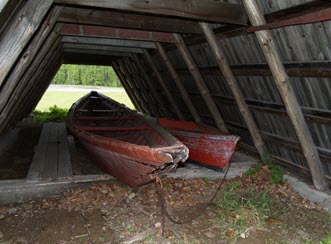
Figure 16a. A roofed structure for large outdoor objects (train cars, wagons, vehicles, etc.) offers some protection from the weather. The roof should overhang beyond the object on all sides by a considerable distance. The ground should drain water away from the objects (gravel or a waterproof concrete pad are two possible options).

Figure 16b. An open shed provides further shelter from the elements.
It is important to be aware that a shelter or enclosure will offer benefits but will also give rise to the possibility of new risks of damage; for example, a roof or enclosed structure may attract birds or rodents, which may lead to the soiling and destruction of elements owing to gnawing or nesting. Assess these new risks and take precautions against them.
For further information on enclosures, consult CCI Note 15/2 Care of Machinery Artifacts Displayed or Stored Outside. An example of an enclosure is also described under Custom-built enclosures.
Pests
All objects kept outdoors can provide both nutrients and habitation for a wide range of pests. Large structures with interior cavities or spaces can become nests for birds and rodents. Bees’ and wasps’ nests present another safety hazard to unsuspecting visitors or maintenance staff who may disturb them (Figures 17a and 17b).
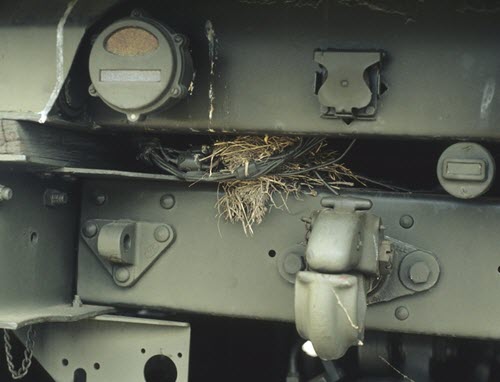
Figure 17a. Bird’s nest in a military vehicle on outdoor display.
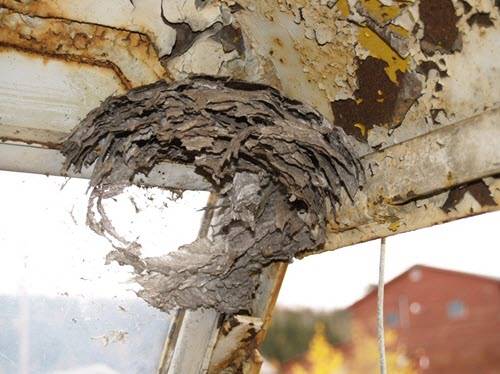
Figure 17b. Remains of a wasp’s nest in the cab of a stored municipal vehicle.
The presence of water, trapped in interiors or soaking into porous components, attracts a range of organisms such as insects, algae, moss, lichen and fungi (Figure 17c).
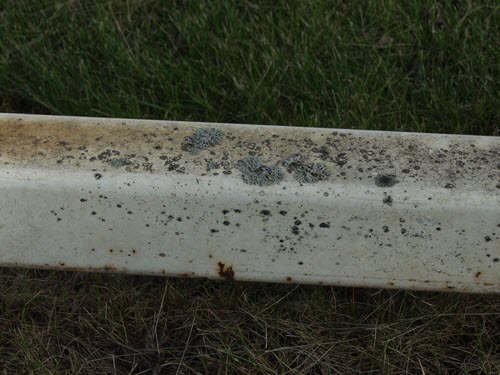
Figure 17c. Lichen has attached onto the paint layer applied to a metal element of an outdoor sculpture.
Often, one infestation can provoke a higher level infestation, as one organism provides a base of nutrition for another, leading to multiple sources of infestation and extending their duration. Organic materials such as wood or leather are particularly vulnerable to the effects of pests, resulting in physical weakening, loss of material and staining. These organisms can cause physical damage through the secretion of organic acids onto the surface of stone and wood, and they can discolour light-coloured surfaces. The acidic degradation of stone surfaces from fungal action leaves them vulnerable to further attack from bacteria. The bacteria, in turn, produce more organic acids, and the degradation of the underlying stone surface progresses rapidly. Results of deterioration from pests are contamination, staining, physical disintegration and erosion.
Recommendations
- Monitor regularly for infestations.
- Ensure that displayed objects can dry out between wettings. Avoid overly shady locations that will provide conditions for growth of organic matter.
- Keep site clean in order to prevent attracting pests (bacterial, fungal, bird or mammal).
- Seal all doors and windows of vehicles.
- Inspect interiors of hollow objects.
- Cover apertures with mesh or netting.
- Prevent access to any possible source of nesting material or nutrient (e.g. upholstery, insulation).
- Remove infestations (nests and debris) as they occur, using approved personal protective equipment.
- If in doubt about removal methods for attached surface accretions (bird droppings, algae, lichen, moss, etc.), contact a conservation professional. These accretions may have caused damage to underlying surfaces, and their removal should be planned according to the most appropriate method.
- Implement a regular schedule of maintenance.
Pollutants
Of all the materials used for creating outdoor objects, stone and metal are among the more vulnerable to the effects of gaseous industrial pollutants, salts and particulates, such as soot and dust. Water plays a very significant role in the degradation processes. Chemicals like sulfur dioxide and nitrogen oxides react with water and atmospheric moisture to form strong acids. Chloride ions, present in a marine environment or from de-icing salts, can promote corrosion of metals in the presence of water or high humidity, resulting in pitted, eroded surfaces and an altered appearance. These acids and salts are capable of provoking strong corrosive reactions in metals (Figure 18) and of reacting with stone surfaces.

Figure 18. This outdoor bronze statue has developed a corrosion patina caused by atmospheric pollutants and exposure to de-icing salts, resulting in a drastically altered appearance (green copper corrosion).
Certain stones are highly susceptible to damage, such as carbonate stones (e.g. marble, limestone, dolostone), carbonate aggregates in concrete and calcareous sandstones (Prikryl and Smith 2007; Figure 19). The black crust often seen on outdoor marble is a sulfated conversion product, formed as the marble is converted to gypsum through acid attack. Soot incorporated into the crust gives it a black appearance. This blackened crust will spall easily, especially if the stone is allowed to weather in an outdoor environment. Attempts at cleaning this blackened surface will result in loss of this surface and exposure of underlying intact material.
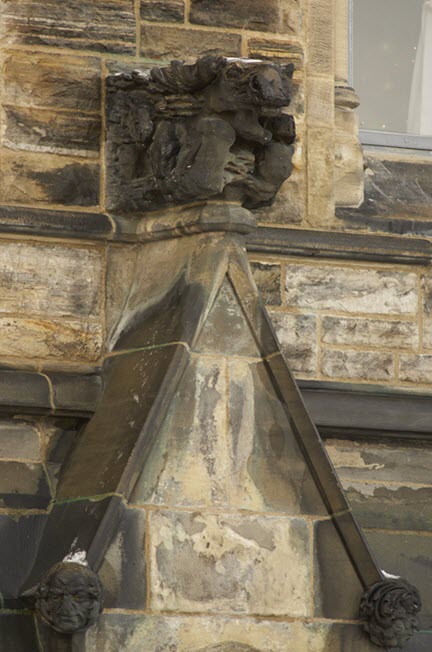
Figure 19. This stone carving (sandstone) shows signs of both physical and chemical weathering. The blackened surface results from a deposit of dirt and soot that has bonded to the chemically altered stone surface below. It is impossible to clean the darkened crust without losing the damaged stone surface.
Biological organisms, such as birds, plants and bacteria, are a secondary source of pollutants. All of these organisms produce acidic residues, which are especially destructive to already weathered and sensitive surfaces.
For more in-depth information on pollutants and their effects, consult Airborne Pollutants in Museums, Galleries, and Archives: Risk Assessment, Control Strategies, and Preservation Management (Tétreault 2003).
Recommendations
- Assess the object’s vulnerability to pollutants. Be aware that sites near roads or in industrial zones can have higher levels of pollutants.
- Limit the use of de-icing salts in the vicinity of outdoor objects.
- Choose indoor or enclosed display rather than outdoor options for sensitive materials, such as calcareous stones.
- Maintain a cleaning program to remove dust and dirt from outdoor surfaces.
- Apply anti-corrosion primers and paints to ferrous-metal objects to seal corrosion-prone surfaces. These coatings must be maintained to prevent ingress of water between the coating and metal surface. Paint or wax coatings can be applied to non-ferrous metals.
Light and ultraviolet
Outdoor objects may include parts made up of organic materials such as wood, leather, textiles (although not common), plastics (like polyester and polyurethane), natural rubber and other elastomers, etc. These are vulnerable to attack by light, especially the UV component of sunlight. Damage typically involves a depolymerization and subsequent gradual disintegration of the surfaces. For example, the surfaces of fibreglass-reinforced polyester sculptures can discolour, dull and become increasingly vulnerable to further deterioration by water. As well, paints and coatings on outdoor objects are vulnerable to high light and UV levels present in sunlight. The result is that many colourants will fade and that paint binders and other surface coatings will crack, chalk and disintegrate. Often varnish coatings applied to wood deteriorate from a combination of light-induced failure and exposure to water. These will break apart and peel away from underlying surfaces. Deterioration of these protective coatings allows water to enter structures with the probable result of mould growth, discolouration and rotting of organic materials. Infrared radiation causes heating, which accelerates many degradation reactions, drying out and embrittling organic materials.
Recommendations
- Choose the site with the vulnerabilities of the particular object in mind.
- Assess the object’s vulnerability to light. Light is ubiquitous in outdoor display, but southern exposures can be more damaging than northern, eastern or western exposures. Materials like polyester resin-infused fibreglass or painted objects are particularly sensitive to prolonged exposure to light.
- Block direct sunlight from interiors of vehicles with blinds, boards, etc.
- Erect large-roofed shelters over objects or groups of objects to prevent exposure to rainwater and direct sunlight. The overhang of the roof should be large enough to screen the object when the sun is at its lowest point (winter solstice).
Examples in preventive conservation practices
Preventive conservation concerns for locomotives housed outdoors
Custom-built enclosures
Locomotives displayed and stored outdoors are exposed regularly to most of the agents of deterioration and are continuously under attack. In this situation, weather, vandalism and neglect cannot be countered effectively, even with the most intense program of inspection and maintenance. Water is the most destructive agent of deterioration to the metal and wood components. Water will be absorbed by wood and other absorbent materials, resulting in corrosion of adjacent metals, biological growth and attack by pests. Water, particularly in association with pollutants in the air and soil, will result in rapid corrosion of metals.
Providing shelter to an outdoor object will help slow down deterioration. For example, a custom-built enclosure now protects the locomotives from the Dawson City Museum and Historical Society from weather and vandalism, with the result that maintenance schedules are considerably less costly and time-consuming (Figures 20a and 20b). Also, access was increased because viewing and examination in the winter months is much less arduous. It is important to keep in mind that by mitigating one risk (e.g. providing shelters), other risks may be incurred (birds nesting in rafters). For further possible control strategies for preserving locomotives housed outdoors, consult CCI Note 15/2 Care of Machinery Artifacts Displayed or Stored Outside.

Figure 20a. Klondike Mines Railway Locomotives at Minto Park, 1978, displayed and stored outdoors in Dawson City.

Figure 20b. The same locomotives in 2005, displayed in a custom-built enclosure, protected from weather and vandalism.
Collectible or breakable components
Detachable or breakable parts can be a target for vandals and can be susceptible to theft. Figure 21a shows a military vehicle displayed at a distance from the main museum building. The windshield has been broken. This vehicle could be displayed in a better controlled location and/or the breakable elements protected with a non-breakable plastic shielding. Figure 21b shows a caged headlight on a locomotive stored outdoors. As a preventive measure, though not ideal, vulnerable parts can be removed, identified with durable tags, documented and stored in a safe place in the museum.
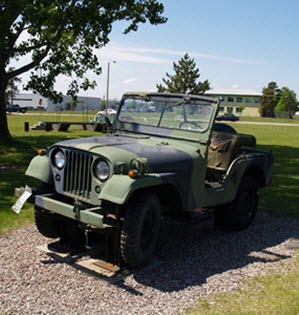
Figure 21a. A military vehicle displayed outdoors at a distance from the main museum building is vulnerable to acts of vandalism.
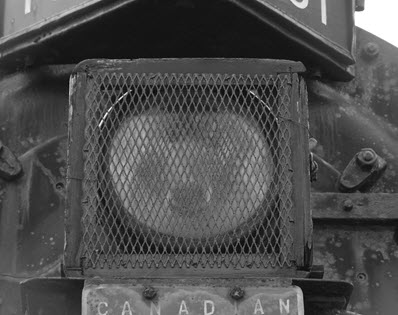
Figure 21b. The headlight of an outdoor steam locomotive protected by an expanded steel screen in a wooden frame (November 2002). The measure is effective against vandalism, but it detracts from the authentic appearance of the vehicle.
Asbestos hazard
Virtually all locomotive boilers were covered with a thick layer of insulating material made of asbestos and/or magnesia, held in place and protected from the weather by a close-fitting sheet-metal jacket. When steam locomotives are put on outdoor static display, water becomes a serious problem. Water reaches the insulation layer via crevices or holes in the jacket and is absorbed by the asbestos. The damp asbestos lagging is held in intimate contact with both the boiler shell and the sheet-metal jacket for extended periods. This often leads to severe corrosion of the thin jacket, resulting in perforation of the metal and contamination of the display site with degraded asbestos. The boiler shell can also suffer from corrosion caused by the wet insulation.
The essential weatherproofing measures and materials, such as paint, caulking and rubber gaskets, must be maintained in order to guarantee their performance even during static display. If the paint and caulking on the jacket have reached the end of their service life (Figure 22), they must be renewed. If the jacket can be sealed and maintained, the asbestos will not present a health hazard. If deterioration continues unchecked, both the jacket and asbestos will have to be removed and discarded by a qualified contractor. This is an expensive procedure and will change the appearance of the locomotive dramatically.
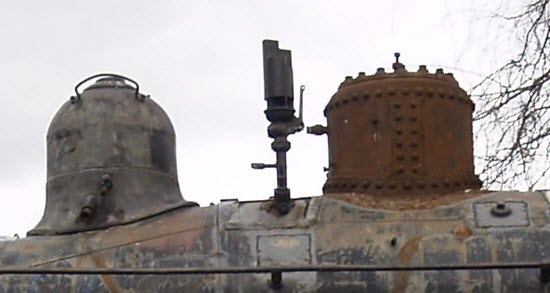
Figure 22. The waterproofing elements (paint, caulking and rubber gaskets) on boiler jackets (cylindrical section) of a steam locomotive require maintenance to prevent potentially hazardous situations and expensive remedial procedures.
Preventive conservation issues concerning an outdoor bronze sculpture
Bronze sculptures, such as Walter Allward’s Justicia (Figures 23a, 23b and 23c), can become disfigured with green corrosion products and uneven streaking due to the interaction of the metal and original patina with acid rain, gaseous pollutants, soot and salts in the outdoor environment.
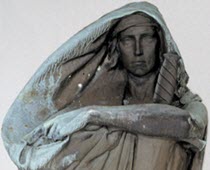
Figure 23a. Justicia by Walter Allward, cast in 1923, installed in 1970 on the grounds of the Supreme Court of Canada, Ottawa. This statue shows green corrosion products and uneven streaking before treatment.

Figure 23b. Justicia during treatment, showing the surface following removal of its green corrosion products.

Figure 23c. Justicia after treatment, following toning of disfiguring streaks and application of a protective coloured coating and wax, showing a more uniform colour that is more consistent with the original appearance.
Any treatment on such objects should only be undertaken by a qualified conservator. Treatment decisions must be based on a thorough knowledge of the materials and the fabrication techniques of the sculpture, as well as on the assessment and documentation of its condition. The basic treatment involves removing loose debris and washing the sculpture with detergent and water to remove dirt, grease and soluble salts. The decision on how far to proceed with removing corrosion should be made in consultations between the curator and a conservator and will be based largely on preserving the artist’s intent. Removing corrosion products may not be desirable because details of the surface can be lost and the underlying metal exposed to further deterioration. Maintenance programs for outdoor bronze sculptures involve annual washing and waxing.
In the case of Justicia, treatment involved thoroughly washing the sculpture with detergent and water to remove green corrosion products (Figure 23b), toning the disfiguring streaks to make them less visible and applying a protective coating (Figure 23c). A maintenance program, including inspection, regular cleaning and care of the coating, was established. This helped to mitigate against future ongoing extensive and expensive treatment.
Vandalism
Michael Hermesh’s The Baggage Handler footnote 1 (Figure 24a), a sculpture installation of a seven-foot unclothed man (made, in part, of burlap, plaster, fibreglass and epoxy) plus 24 real-life suitcases, attracted much attention in the small community where it was exhibited. Upon installation of the sculpture, a small metal plate (a cache-sexe) was requested in response to a city official’s objection to public nudity. This metal plate was soon removed as it only drew attention to that which it was designed to hide. Within a short space of time, the figure, as well as the attendant suitcases, were the subjects of physical attacks.
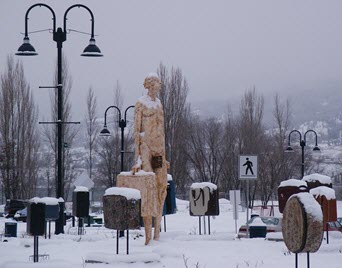
Figure 24a. The Baggage Handler (with addition of metal cache-sexe) by Michael Hermesh.
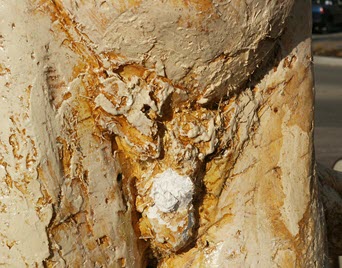
Figure 24b. Detail of The Baggage Handler. Close-up of a vandalized area.
Attempts were made to topple the sculpture, resulting in fracturing at the ankles. Additionally, suitcases were slashed and the figure’s penis removed (Figure 24b). Several weeks later, the break site at the figure’s penis was spray-painted green (Figure 24c).

Figure 24c. Detail of The Baggage Handler. Earlier damage now sprayed with green paint.
An unsolicited attempt to remove the offending paint resulted in further damage to the weakened structure. Following further assaults against the structural integrity of the work, The Baggage Handler was removed from this display location for restoration, and a different, more protected site was arranged for future display.
Bibliography
Bouchard, M., B.B. Considine, K. Posner and J. Wolfe. Conserving Outdoor Sculpture: the Stark Collection at the Getty Center. Los Angeles, CA: Getty Conservation Institute, 2010.
Canadian Conservation Institute. Care of Machinery Artifacts Displayed or Stored Outside. CCI Notes 15/2. Ottawa, ON: Canadian Conservation Institute, 1993.
Daly Hartin, D. Conservation guidelines for outdoor murals. Ottawa, ON: Canadian Conservation Institute, 2012.
Kipper, P.V. The Care of Bronze Sculpture, Recommended Maintenance Programs for the Collector, 4th ed. Loveland, CO: Path Publications, 2007.
Mossholder, D.L. “Save Outdoor Sculpture!: A Community-Based Conservation Program.” The Getty Conservation Institute Newsletter, 22, 2 (Summer 2007), pp. 17–20.
Naudé, V.N. Sculptural Monuments in the Outdoor Environment: A Conference Held at the Pennsylvania Academy of the Fine Arts, Philadelphia, November 2, 1983. Philadelphia, PA: Pennsylvania Academy of the Fine Arts, 1985.
Naudé, V.N., and G. Wharton. Guide to the Maintenance of Outdoor Sculpture, 2nd ed. Washington, D.C.: American Institute for Conservation of Historic and Artistic Works, 1995.
Parks Canada. Standards and Guidelines for the Conservation of Historic Places in Canada (PDF format), 2nd ed. N.p: Parks Canada, 2010.
Prikryl, R., and B.J. Smith. Building Stone Decay: From Diagnosis to Conservation. London, UK: Geological Society of London, 2007.
Prytulak, G. Outdoor Storage and Display: Basic Principles. CCI Notes 15/8. Ottawa, ON: Canadian Conservation Institute, 2010.
Prytulak, G. Outdoor Storage and Display: Remedial Measures. CCI Notes 15/9. Ottawa, ON: Canadian Conservation Institute, 2010.
Save Outdoor Sculpture! (SOS!). Designing Outdoor Sculpture Today for Tomorrow. Washington, D.C.: National Institute for the Conservation of Cultural Property, 1996.
Scott, D.A. Copper and Bronze in Art: Corrosion, Colorants, Conservation. Los Angeles, CA: Getty Publications, 2002.
Selwyn, L.S. Metals and Corrosion: A Handbook for the Conservation Professional. Ottawa, ON: Canadian Conservation Institute, 2004.
Selwyn, L.S., and P.R. Roberge. “Corrosion of Artifacts Displayed in Outdoor Environments.” ASM Handbook Volume 13C: Corrosion: Environments and Industries, pp. 289–305. Materials Park, OH: ASM International, 2006.
Tétreault, J. Airborne Pollutants in Museums, Galleries, and Archives: Risk Assessment, Control Strategies, and Preservation Management. Ottawa, ON: Canadian Conservation Institute, 2003.
Ward, P., D. Grattan, R.L. Barclay, and J. Hay. Totem Poles Displayed Outside, revised. CCI Notes 6/8. Ottawa, ON: Canadian Conservation Institute, 2008.
Winkler, E.M. “Decay of Stone.” In G. Thomson, ed., Preprints of the Contributions to the New York Conference on Conservation of Stone and Wooden Objects, 7–13 June 1970, vol. 1, 2nd ed. London, UK: International Institute for Conservation of Historic and Artistic Works, 1971, pp. 1–14.
Yngvason, H. Conservation and Maintenance of Contemporary Public Art: A Conference Hosted by the Cambridge Arts Council, Cambridge, Massachusetts, October 26–28, 2001. Cambridge, MA: Cambridge Arts Council, 2002.
© Government of Canada, Canadian Conservation Institute, 2018
Published by:
Canadian Conservation Institute
Department of Canadian Heritage
1030 Innes Road
Ottawa, ON K1B 4S7
Canada
Cat. No.: CH57-4/6-9-2018E-PDF
ISBN 978-0-660-28000-4
© Government of Canada, Canadian Conservation Institute, 2018
Published by:
Canadian Conservation Institute
Department of Canadian Heritage
1030 Innes Road
Ottawa, ON K1B 4S7
Canada
Cat. No.: CH57-4/6-9-2018E-PDF
ISBN 978-0-660-28000-4